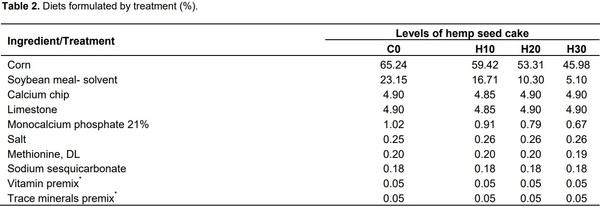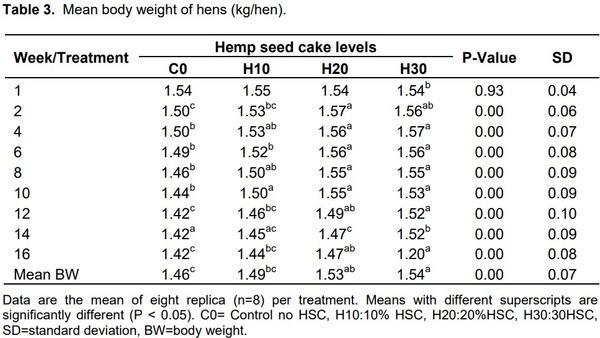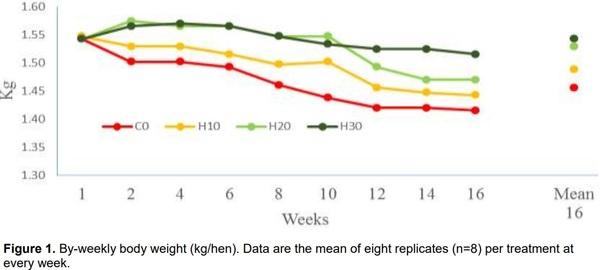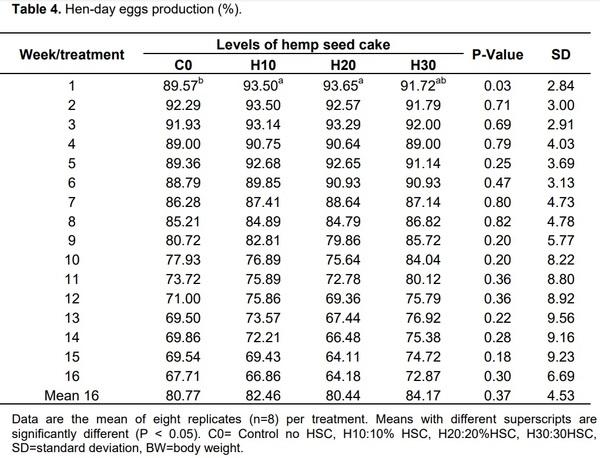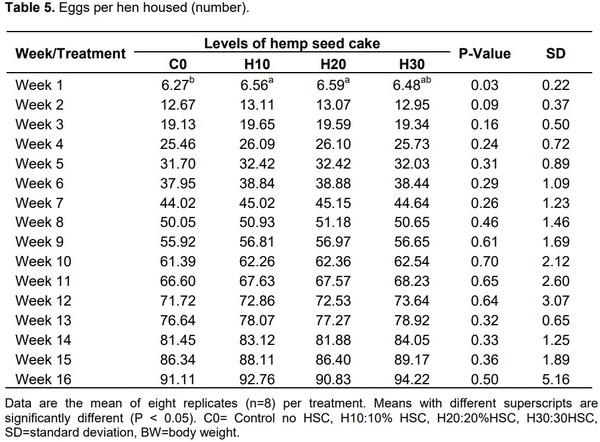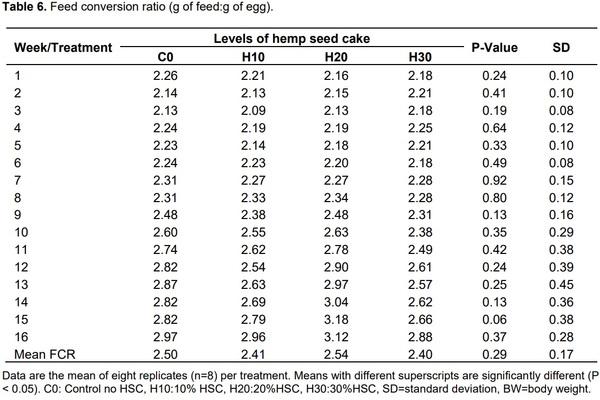INTRODUCTION
The Food and Agriculture Organization (FAO) forecasts that the human population will increase by 30% by 2050 (FAO, 2019) with corresponding increase in demand for food. Animal protein, the largest component of human food is entirely dependent on livestock production channels as its source. Over 70% of the cost of livestock production is feed, and the second largest component and cost of feed is the crude protein, a segment that has been challenged for its sufficiency for decades forcing the commercial and scientific communities to be innovative and creative. Several unconventional and less conventional ingredients have been explored as alternative protein sources for livestock in the last several decades.
Hemp (Cannabis sativa L.) is an annual herbaceous plant belonging to the family Cannabinaceae (Turner et al., 1979), traditionally grown for fiber and seed production. Whole hemp seed contains approximately 25% crude protein, 33 to 35% oil, and 34% carbohydrate, in addition to a broad range of vitamins and minerals (Darshan and Rudolph, 2000; Callaway, 2004; House et al., 2010).
Hemp and its products (hemp seed cake) have not been established to be economical alternatives to conventional protein sources for animal feeding; however, significant research has been published on their nutritional value to human and animals.
Significant research across the globe that has gone into evaluating the safety of the ingredient showed that including hemp in animal feed is safe and offers benefits for improved animal performance and human health (Gakhar et al., 2012; Jing et al., 2017). For example, hemp seed oil contains 75 to 80% polyunsaturated fatty acids (PUFA), including 60% linoleic acid (LA) and the n-3 fatty acid α-linolenic acid (ALA) (Parker et al., 2003; Gakhar et al., 2012; Neijat et al., 2014). Given the high ALA content of hemp oil, significant increases in both ALA and the long-chain n-3 fatty acid eicosapentaenoic acid (EPA) and docosahexaenoic acid (DHA) has been documented in eggs, as a function of increased hempseed and hempseed oil inclusion (Gakhar et al., 2012) without effects on the overall sensory qualities of the eggs (Goldberg et al., 2012).
Hemp seed oil also contains approximately 4% gamma-linolenic acid (GLA), a unique n-6 fatty acid that serves as an intermediate for the formation of anti-inflammatory eicosanoids, which may have similar anti-inflammatory and anti-proliferative properties as EPA and DHA (Fan and Chapkin, 1998; Leizer et al., 2000; Kapoor and Huang, 2006). These fatty acid compositions, especially the n-3 fatty acids have led to researches that have explored opportunities to increase n-3 content in meat and eggs for the positive impact in human health (Erasmus, 1993; Lewis et al., 2000; Gonzalez-Esquerra and Leeson, 2001; Silversides et al., 2002; Ribeiro et al., 2014). Additionally, given the high linoleic acid content, researches indicate that hemp products in layers may also improve egg weight (Parker et al., 2003; Silversides and LeFranc, 2005).
Hemp products are also shown to be excellent sources of yolk pigmentation, lutein and fatty acid enrichment of eggs (Goldberg et al., 2012; Mierliță, 2019).
In the past, the cultivation of hemp was prohibited due to the high content of Δ-9 THC, a psychoactive substance present in the hemp plant. In the recent decades, regulatory changes undertaken by several countries across the globe allowed for the legal cultivation of industry hemp under a license that permits plants and plant parts of the genera Cannabis, the leaves and flowering heads of which do not contain more than 0.3% Δ-9 THC (wt/wt), and includes the derivatives of such plants and plant parts (Malone and Gomez, 2019; USDA, 2019). The nutritional profile, in addition to the increase in production and availability of hemp and hemp products create opportunities to use them in livestock diets (Gakhar et al., 2012).
Genetic improvements to limit Δ-9 THC to less than 0.3% (w/w) in hemp leaves and flowering heads of the genera Cannabis, have made them safer as a feed ingredient.
The use of HSC has not been approved in diets for any class of livestock in the USA due to a lack of research in support of its safety and efficacy. Therefore, research on the safety and benefit of hemp in layer feed is needed. The current study is designed to determine the effect of increasing levels of HSC on the performance of white laying hens on a protocol preapproved by CVM-FDA in a commercial setting per declared animal welfare policy of the producer.
MATERIALS AND METHODS
Experimental design
The study was conducted at a commercial layer farm in Lancaster County, PA. A part of the commercial layer farm was chosen and marked for the study and hens were organized in treatments as the following.
Considering that this breed reaches peak production between 26 and 36 weeks, eight hundred (800) Bovan white caged hens in lay, 30 weeks of age, were randomly distributed in 4 treatments of 200 hens per treatment based on inclusion levels of HSC. Each treatment comprised 8 replicates or cages of 25 hens each. The treatments were: a control diet - regular diet with no HSC, regular diet with 10% HSC (H10), regular diet with 20% HSC (H20) and a regular diet with 30% HSC (H30). The observations per protocol were made over a period of 16 weeks following a 3-week acclimation.
Acclimation of test animals
In order to eliminate the impact of the new ingredient and its differential inclusion levels, the hens under study were subjected to a period of acclimatization for 3 weeks when the respective treatments were fed with the study diets allowing for acclimatization of feed consumption and gut environment. Observations and data from the period of acclimation were not considered for the purpose of this study.
Environment and management
All the hens under study were subjected to the following environmental and management uniformly.
(1) Special feed troughs were designed to bypass the existing auto-feeders and the hens were fed manually once a day.
(2) An iso-caloric, and iso-nitrogenous diets of nutrient levels at 113.5 g/hen/day consumption as per breed standard were designed across all treatments. Continuous water, identical environment and management were offered uniformly across treatments.
(3) Hens were weighed prior to start of study by cage and composition of hens per cage was managed for uniformity of body weight across treatments.
(4) Environmental conditions were maintained at 23-24°C, house temperature, 40-60% humidity, 30 Lux lighting for 15-16 h of lighting per day and air movement between 2550 and 3400 m 3 /h/1000 hens.
Inclusion and exclusion criteria
In order to establish uniformity of population across treatments, the cages were individually weighed for initial weights and, hens moved between cages to maintain a total body weight difference not exceeding 2.5%. These weight-adjusted cages were then randomly distributed within the 32 cage locations with 2 cages of the same treatment together. A plastic plate was installed between each cage to prevent hens from picking feed from adjacent cage feeder. Ailing and visually sick hens were weighed, euthanized, necropsied and disposed of per farm disposal policy; culled hens from the study were not replaced.
Blinding of study personnel and treatment randomization
In order to eliminate any treatment or observational bias, all study personnel including investigators and caretakers were not apprised of the dietary treatments and a combined technique of color coding and randomization of treatments was implemented at the farm. Furthermore, treatment locations were established before the start of the study. The treatments were identified with codes not revealing the level of dietary HSC being tested, and the randomization was performed at the Wenger Feeds Nutrition and Quality Laboratory, thus eliminating the potential of anyone at the farm level knowing the details. The study personnel at the farm received only the cage colors without any details about the study treatments.
Source and composition of HSC The hemp seed for producing the cake (HSC) used in the current study was grown locally, procured and processed by Susquehanna Mills, 349 Village Rd, Pennsdale, PA, USA, with the geographical latitude 40.899938, -77.570296.
The nutrient analysis of HSC from weeks 1 and 8 are presented in Table 1. The nutritional values and cannabinoid residues did not show an abnormal composition or safety concern to use HSC in livestock. The analyzed THC values were below the laboratory detectable levels of the <0.005% for HSC and <0.0025% for finished feed which were below the legal maximum allowed level of 0.3% (Tables 1 and 2).
Finished feed
The feed had a dry matter (DM) content of 87.88 in C0, 88.79 in H10, 89.97 in H20 and 91.6% in H30.
Study parameters
Feed intake (g per hen/day)
Study hens were offered a uniform free-choice restricted amount of feed at 113.5 g/hen/day per Bovan White Commercial Product Guide, North American Version, 2019 for the age and stage of production. The amount of feed per cage was kept constant across all treatments. A pre-weighed 2.84 kg of feed was provided to each cage of 25 hens every day at the same time.
On a weekly basis, the residual feed from the feeders was collected, weighed and subtracted from the original amount of feed fed to each cage to determine the amount of feed consumed per cage. The total amount consumed was divided by the number of hens in the cage to obtain the actual feed intake per hen per day.
Hen body weight (kg)
The 25 hens were weighed along with cage for tare body weight on day 1 of the study followed by every other week. On day 1, all cages were balanced by moving hens to maintain a difference between cage weights that did not exceed 2.5%.
Hen-day production (%)
The egg production was determined by collecting, recording and storing all eggs every day from each cage. The data of eggs per cage were sent weekly to the Wenger Feeds Nutrition and Quality Control Laboratory for further analysis. The percent hen-day egg production was calculated by dividing the total number of eggs produced in a day by the total number of hens in a cage that day, multiplied by 100.
Eggs per hen housed (No.)
The number of eggs per hen housed was calculated as the mean number of eggs collected during a week adjusted to the number of live hens and days of production of the week and reported as a cumulative figure for the length of the study.
Feed conversion ratio
The feed conversion ratio (FCR) was calculated by dividing the amount of grams of feed consumed by laying hens by the amount of grams of egg produced (FCR=g of feed consumed/g of egg). The FCR was calculated on a weekly basis throughout the study.
Livability (%)
The livability was recorded at the end of each week as the number of hens alive per cage and per treatment. As a routine, daily mortality was recorded from each cage along with the gross cause of death. Ailing and visually sick hens were weighed, euthanized, necropsied and disposed of per farm disposal policy; the dead hens were removed and disposed per farm disposal policy as well; culled hens from the study were not replaced. Any mortality above 2% per day per treatment or row would call for a detailed investigation of the cause, including a Veterinarian visit.
Statistical analysis
All parameters studied, except the livability were analyzed as a completely randomized design with cage as the experimental unit with the General Linear Model Procedure (PROC GLM) of SAS (SAS, 2012). The treatment mean separation was carried out with the Tukey Multiple Range test with a probability of error of 5% (P<0.05).
RESULTS
Feed intake
On account of restricted and controlled feeding, no residual feed was noticed in feeders all through the study period. Therefore, no differences in feed intake could be recorded. In other words, the observation indicated that there was no feed refusal in any of the HSC fed hens, similarly as the control. The feed intake adjusted for mortality and the average daily feed intake at the end of the study did not show any difference between treatments; control was at 113.56 g compared to 114.03, 113.71, and 114.28 g in the H10, H20 and H30, respectively.
Body weight
A general trend of reduced overall body weight across all treatments including control was noticed during the study. Feeding HSC to laying hens showed improved mean weekly body weights compared to the control treatment (Table 3 and Figure 1) that was statistically significant at higher levels of inclusion. The trend in general showed no difference between control and 10% inclusion level, however, presented a positive trend at 20 and 30% across most parts of the study. The mean of weekly mean body weights at the end of the study was higher at the 20 and 30% HSC fed hens over the control; however, the difference was not statistically significant between 0 and 10% and 20 and 30%.
Hen-day eggs production (%)
The weekly mean hen-day production data of various treatments are presented in Table 4.
The hen-day production was not significantly affected in a consistent way by the increasing levels of feeding HSC. The mean hen-day production differences between the treatments at the end of the study also remained insignificant.
An overall tapering trend of hen-day production postpeak, atypical to the breed, consistently across all treatments, including the control, was noticed throughout the study. The only significant production difference was noticed in week 1 between the control at 89.57% and the H10 and H20 at 93.50 and 93.65%, respectively.
Eggs per hen housed
The eggs per hen housed (Table 5) did not show a consistent effect of the HSC over the control treatment; just right after the acclimation there was an inconsistent increase of the 10 and 20% HSC inclusion over the control that did not persist towards the end of the study as evidenced by insignificant difference.
Feed conversion ratio
The weekly mean FCR of treatments under study are presented in Table 6 and the trending graphs in Figure 2. The gross trend of FCR followed the expected postpeak increase across all the treatments and inconsistent trends across weeks. The overall impact of varying levels of HSC in the diet on feed conversion ratio was found to be statistically insignificant.
Livability
A total of 789 out of 800 live hens were processed at the end of the study; only 11 hens or 1.35% of total population were dead for physical, non-feed or nondisease related causes. No ailing or visually sick hens were noticed during the study and at no point was the mortality over 2% in a row or a treatment that called for a veterinarian visit. Also, the hens did not call for a medication treatment all through the study. The total mean livability at 16 weeks was 99.5% in the control treatment compared to 99, 98.5 and 97.5% in the H10, H20 and H30, respectively. The overall livability throughout the study was trend-free and was higher than the breed standards of 98% at week 30 and 95.5% at week 49 (Bovan Management and Commercial Product Guide, 2019).
DISCUSSION
The primary purpose of this study was to evaluate the effects of feeding HSC on the performance of commercial laying hens. Most of the published literature on this subject and related areas is in other species and with using whole hemp seed or hemp oil or other hemp products. Given the extremely limited published research on feeding HSC in livestock, the authors are constrained with few supporting references to quote on the findings. Silversides and Lefrancois (2005) and Gakhar et al. (2012) studied the effect of feeding HSC for periods between 4 and 12 weeks at levels not exceeding 20%. In an attempt to stretch test its feeding safety in laying hens, this study includes a higher level of HSC (30%) with an acclimation period contemplating the recommendation of Neijat et al. (2014) who opined that hens could tolerate higher levels of hemp seed (up to 30%) with a longer period of adaptation.
Researchers from European Monitoring Centre of Drug Addiction have reported that HSC may be fed safely to about 30% of the diet to hens (EFSA, 2011). Neijat et al. (2014) reported the use of hemp seed up to 30%; Hale and Schone (2013) reported HSC up to 10% and Gakhar et al. (2012) reported up to 20% of hemp seed did not have adverse effects in laying hens.
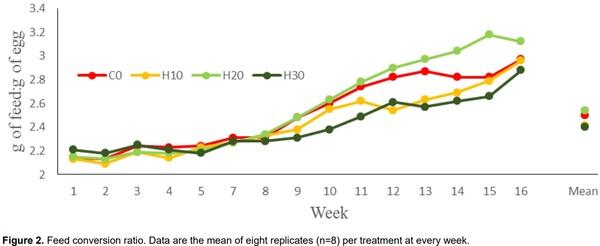
Although the study hens were fed a restricted amount of a balanced diet, there was no evidence of refusal or reduced consumption in hens during the acclimation and subsequent feeding for 16 weeks. Similar findings were reported by Silversides and Lefrancois (2005) with the inclusions of hemp seed meal at 0, 5%, 10%, or 20%, where the diet did not significantly affect feed intake, body weight, and egg production. However, the current findings contradict those of Halle and Schone (2013) who reported a significantly lower feed intake when HSC was supplemented at 15% versus 5 and 10%. The benefit of the acclimation period may be attributed to the finding in the current study that may have helped the hens adjust to the new ingredient.
A general trend of under-performance per breed standards, in terms of body weight was noticed in all the experimental groups, including control. Neijat et al. (2014) in their study with hemp seed concluded that the overall hen performance (feed intake, rate of lay, egg weight, and body weight gain) was not influenced by the inclusion of graded levels of hemp seed up to 30% compared with hens fed the control diet. Silversides and Lefrancois (2005) also had shown that hempseed meal up to 20% of the diet supported production of laying hens in their 4-week study. However, Jing et al. (2017), Silversides and Lefrancois (2005) observed a reduction in mean hen body weight over their study period regardless of the levels of inclusion. The generalized drop in body weight observed in this study may be attributed to undue stress owing to unusual intervention and handling for observations per study protocol. Additionally, data from Weather Trends showed that the temperature during the study period fluctuated between 4°C at the beginning of the study (mid-January) and 28°C at the end of the study (end May) causing heat stress resulting in the drop in body weight and egg production. Previous studies evaluating effect of heat stress in laying hens showed that a temperature above 26°C reduced the laying rate and the number of follicles and triggered apoptosis (Gui-Ming et al., 2020). Similar effect was noticed generally across all the treatment groups except that the impact was relatively lower in HSC fed groups with a trend directly proportional to the inclusion level. This observation is in line with that of Odani and Odani (1998), who reported the stress releasing effects of hemp was due to the lower omega 6:omega 3 ratio, and the 21 amino acids present in hemp. Additionally, hemp is a rich source of magnesium (0.42 and 0.48%) (Table 1) which is reported to support neurotransmitter functions in the body and reduces stress and anxiety in laying hens (Donoghue et al., 1990).
It was interesting to note that despite the stress effect across all experimental groups, the same was less pronounced in HSC fed groups that showed a positive trend in body weight gain that was statistically significant at higher levels of inclusion: 20 and 30%. A similar drop in body weight gain reported by Silversides and Lefrancois (2005), might have been due to the short period of investigation (4 weeks) with no acclimation period. The current 16 week feeding study potentially helped the hens overcome the alien ingredient stress.
Although the hen-day production declined overtime across all treatments, there was not a significant HSC treatment effect. The general decline of hen day egg production overtime may also be associated with the constant handling and manipulation of the birds as previously described. This finding concords with the results reported by Mierliță (2019) who report no effect on hen day production when HSC was included at 20.32% in the feed of laying hens. However, these results contradict the findings of Halle and Schone (2013) who reported a reduced feed intake, egg mass production and feed-to-egg mass ratio at 15% versus 5 and 10% in their 24 week study.
Eggs per hen housed were not significantly affected by the supplementation of HSC, except in the first week after the adaptation period that did not persist any further. The authors have not been able to find any published literature evaluating the effect of HSC on eggs per hen housed.
Although the feed conversion ratio in this study trended to be higher over the time, there was not a significant HSC treatment effect in any of the weeks evaluated; these results agree with those reported by Mierliță (2019) who observed a reduction of 4 points in feed conversion ratio (1.87 versus 1.83) when HSC was supplemented at 20.32% compared to the control treatment, however was not found to be statistically significant. The results also contradict those of Hale and Schone (2013) who while experimenting with three different types of cakes noted a significant trend of FCR reduction with increasing inclusion levels of HSC of 5, 10 and 15% at 1.94, 1.93 and 1.89, respectively.
All the treatments tested in this trial surpassed the livability levels specified by the breed (Bovans White Commercial Product Guide, North American Version, 2019) at week 30 (98%) or at week 49 (95.9%); the average livability of the trial was 98.65% with 789 out of 800 birds surviving at the end of the study. The recorded mortality of 11 birds was caused due to physical trapping of the hens in the cages and not specifically related to any level of HSC treatment.
Conclusions
The results of the present study infer that HSC can safely be used as a feed ingredient up to 30% of inclusion in the feed of commercial laying hens since the performance parameters (feed intake, body weight, hen day production, eggs per hen housed, feed conversion ratio and the livability) were not adversely affected.

